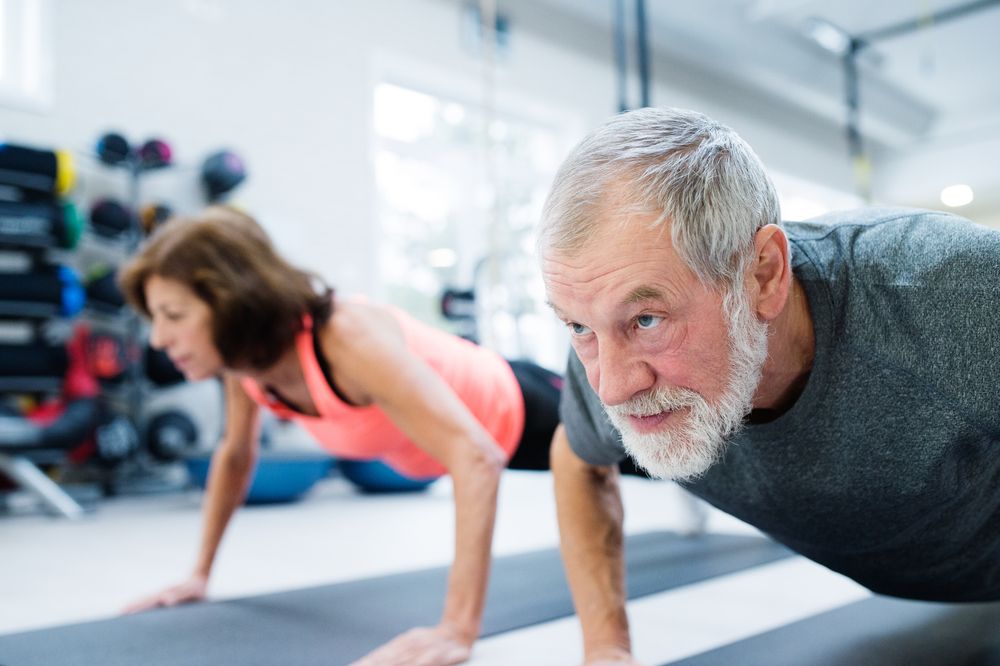Engaging in regular exercise brings with it a host of positive results, including a lowered risk of disease, improved management of weight and chronic illness, and more restorative sleeping and eating patterns. (Learn more: How Does Exercise Contribute to Positive Health?)
For those who are living with a chronic illness or have a family history of diseases, such as heart disease or type 2 diabetes, exercise can provide a method of positive symptom management, prevention, and potential reversal. (Learn more: What Diseases Are Positively Impacted by Exercise?)
Though it is possible to overdo it or jeopardize your health through overexertion, a medical professional can create a personalized exercise plan that will benefit you and help you achieve your health goals.
Different styles of exercise will have a different effect, but all contribute to improved mental and physical wellness, as well as a stronger immune system.
Work with a professional to find the right combination of exercises to suit your goals, create a plan, and track your progress to see how your symptoms improve over time. (Learn more: What Is the Best Way to Create an Exercise Program that is Right for Me?)
How Does Exercise Contribute to Positive Health?
The positive effects of exercise include:
- Weight loss and management. Many people begin their journey toward finding an exercise program to lose weight. Though this is often a healthy goal, especially when you are struggling with being overweight or obese, it is difficult to stay motivated by keeping your eyes on the scale.
Slow and sustained weight loss, or maintaining a healthy weight over a long period of time, is often a byproduct of regularly engaging in exercise and making other healthy lifestyle choices — as long as the number of calories burned outnumbers the number of calories ingested through food.
- Reduced risk of cardiovascular illnesses. Engaging in exercises that raise the heart rate, like jogging, swimming, and biking can strengthen the heart. It also serves to oxygenate the body and improve circulation, which in turn has a positive impact on the cardiovascular system. Several studies have shown a correlation between exercise and a reduced risk of high blood pressure, lower cholesterol levels, and decreased risk of death due to heart disease and heart attack.
- Positive management of blood sugar and insulin levels. Exercise can make it easier for your body to manage insulin levels and lower blood sugar. Regular exercise over time can help to keep type 2 diabetes at bay and decrease the risk of metabolic syndrome, as well as the need for medication to manage those disorders.
- Increased mental clarity and focus. It is not just your body that benefits from a regular exercise program — your brain does too. When you work out, your body releases proteins that boost how your brain functions and even improves its structure.
- Improved disposition and mood management. Exercise can trigger the release of chemicals in the brain that increase a sense of contentment and relaxation. For those who struggle with occasional depression, anxiety, and other mental health symptoms, exercise and healthy nutrition along with therapeutic intervention and monitoring can help to decrease, if not eliminate, the need for medication.
- Better quality of sleep. High anxiety, depression, and a lack of physical exertion can all be causes of poor sleep. Difficulty falling asleep or staying asleep can result in a lack of restorative sleep necessary to repair physically and process mentally.When your mood is improved, and your body is tired from exercise, it is easier to quiet the mind, fall asleep, and stay asleep long enough to reap the benefits of uninterrupted sleep cycles. Exercise has been shown to have a significant impact on the quality and duration of sleep.
- Stronger bones and muscles. Weight-bearing exercises and the impact of cardiovascular exercises can both improve bone density and muscle strength. As you age, continued exercise can help to prevent bone density loss as well as improve muscle mass, which improves your abilities to withstand the impact of falls or other accidents.
- Reduced risk of certain cancers. Regular exercise may decrease the risk of developing breast cancer, colon cancer, uterine cancer, and others.
- Improved balance. The risk of falls increases with age, especially as bone density decreases and proprioception changes. Regular exercise can help to increase the sense of stability and body awareness, strengthening muscles and improving balance.
- Increased life expectancy. Eating healthy means exposing the body to fewer toxins and inflammation, which in turn decreases wear and tear on vital organs. Additionally, exercise has been shown to have a positive impact on bone density and decrease frailty over time.
Can Exercise Harm Your Health?
Exercising too often or too intensely can harm your health. For example, overdoing it with any kind of exercise when under the weather or fighting off illness can serve to lower the immune system further and make it more difficult to heal. Similarly, continuing to exercise through injury can do permanent damage, as can taking drugs or dangerous supplements in an effort to improve performance.

Over-exercising, or purposefully choosing to exercise to burn well beyond the number of calories ingested regularly, is not healthy. Though the goal of weight loss is to burn more calories than ingested, burning thousands of calories more than you eat on a regular basis can be damaging to the body as well as the mind.
In fact, a commitment to exercise that goes beyond healthy boundaries may be defined as compulsive exercise or exercise addiction. This must be addressed as a medical and mental health disorder.
What Are the Signs of Exercise Addiction?
Just like with any vice addiction, exercise addiction does not happen overnight. Instead, it occurs in stages, often developing over time as a means and mechanism for coping with unhealthy assumptions or perspectives associated with trauma.
Too much of a good thing can be detrimental, and when it comes to exercise, there are signs that you may be at risk of or in the midst of an addiction that requires treatment. Some signs of exercise addiction include:
- Feelings of agitation when unable to exercise due to circumstances or illness.
- Compulsive exercise after eating.
- Obsessive counting of calories taken in and calories burned, with an eye on ensuring a far higher burn than intake.
- Continuing to exercise through injury and illness, even with the knowledge that doing so may cause more injury.
- Cutting back in other important areas of life (like work or relationships) to exercise.
- Exercising in secret because you know that the amount of time you spend exercising is abnormal.
- Being unable to moderate the amount of exercise done in any given period.
What Diseases Are Positively Impacted by Exercise?
- Cardiovascular disease: The heart and cardiovascular system as a whole benefit from regular exercise. Regular increases in heart rate to a safe level can make the heart stronger, improve its ability to function properly, and decrease damage done by inflammation caused by stress.Even gentle exercise like yoga can have a positive impact on cardiovascular disease, helping to decrease the risk of those who are at high risk of developing the disorder. Additionally, when exercise was utilized as a part of an early rehabilitation program after myocardial infarction, health-related quality of life was shown to improve significantly.
- Mood disorders: For individuals living with bipolar disorder, major depressive disorder, and other mood disorders, early death and lower overall quality of life (compared to the general population) is the norm, often due to obesity and diabetes. With exercise, however, long-term outcomes of mood disorders have been shown to improve — as long as exercise is a part of a larger treatment plan that includes nutritional changes, medication, and other lifestyle modifications.
- Addiction disorders: When struggling with a physical and emotional dependence on alcohol or other drugs, a range of positive lifestyle choices can help you to get through withdrawal symptoms and create a new life without addiction. One meta-analysis found that numerous studies supported the notion that exercise makes withdrawal easier to overcome and increases abstinence rates. It also decreases symptoms of depression, which are common among people undergoing addiction treatment.
- Diabetes: Numerous studies support the efficacy of exercise for the treatment of type 2 diabetes. One recent study even found that older adults who engaged in different types of exercise three times a week demonstrated improved health-related quality of life across multiple areas, including general health, vitality, mental health, systolic blood pressure, and hip-to-waist ratio.
- Cancers: Countless studies have explored the ability of different types of exercise to impact the development of various cancers, and almost all show lower rates of cancer development among populations that exercise regularly.
A recent systematic review of systematic reviews of exercise in cancer found that exercise was effective in the prevention of certain cancers and also helpful during treatment and recovery. Moderate to vigorous activity was shown to have the best effect on reducing the development of certain cancers. Therapeutic exercise helped patients to manage symptoms related to treatment and recovery, and improve treatment outcomes.
Not only does exercise benefit people living with or attempting to prevent the development of chronic disease, but it has also been shown to benefit caregivers of family members who are ill and recovering.
Do Different Exercises Impact Your Health Differently?
Diverse styles of exercise have a unique impact on the body, taxing different systems and building up endurance in various areas of function.
For healthy individuals, engaging in all three styles of exercise is recommended to gain the most benefit across systems. In some cases, when there is an underlying mental health disorder or physical ailment present, a specific style of exercise may be indicated over another.
Cardiovascular Exercise
Some studies show that engaging in cardiovascular exercise or exercise that maintains an accelerated heartbeat can have a positive effect on:
- Body composition.
- Weight management.
- Strength.
- Risk of cardiovascular disease, cancers, and diabetes.
- Memory.
- Meta-cognition.
- Skeletal strength.
- Mood.
Weight-Bearing Exercise
Lifting weights or using the weight of the body for exercise do more than just increase muscle strength. Other benefits include improved function and results in:
- Joint function.
- Bone mass and density.
- Body composition.
- Muscular mass.
Therapeutic Exercise
In cases of injury or chronic disease, it is not always possible to engage fully in rigorous exercise, or it may not be possible to engage long enough and intensely enough to enjoy the full benefits. Therapeutic exercise offers the ability to gain muscle strength, flexibility, and cardiovascular benefit without overburdening the body or causing more damage.

For example, water aerobics and swimming are positive choices for patients struggling with joint pain or who have difficulty bearing their weight. Similarly, yoga has been shown to be a positive addition to therapeutic recovery from injury and chronic disease. While both of these are encouraged for patients who are healthy and offer many of the same benefits, they may be the best option for someone limited in their ability to work out more rigorously.
How Do I Know Which Types of Exercise Will Be Most Beneficial for Me?
Safety is primary when it comes to determining which style of exercise to pursue. If you do not feel physically safe in taking part in a particular sport, or if you injure yourself frequently during the course of engagement, then you will have little opportunity to maximize the benefits of exercise fully.
Similarly, if you are diagnosed with a chronic condition, you may find that certain types of exercise put you at risk or injury or harm. It is important to have a good idea of the types of recreation to avoid as well as the ones that will be most beneficial to help you manage symptoms.
Personality and interest play a role in the style of exercise that will help you most as well. Even if a specific type of exercise is perfect for your condition, if you hate doing it, it is unlikely that you will be able to sustain the regular engagement necessary for optimum health. Finding exercises and sports you like to do, and that makes you feel good while you are taking part in them, is key to getting the most out of your workouts.
What if I Can’t Exercise Because of Chronic Pain or Injury?
Immediately after a serious injury or during flare-ups and periods of difficulty managing a chronic illness, it is more than okay to take a break from exercise and allow your body the time and space it needs to repair.
Rest is a crucial part of the process of exercise. It is during this period that the body can restore itself and maintain optimal function. In fact, exercising hard every day or multiple times a day is not recommended for this reason.
Should your recovery take a significant period of time, stopping you from engaging in your usual level of exercise, there are several therapeutic and gentle exercises you can do to keep moving regularly. These include:
- Walking, even for short distances.
- Water-based exercises, like walking, repetitive movement, or stretches in a pool.
- Restorative yoga.
- Tai chi.
- Stretching.
Start by engaging in short periods of gentle exercise and slowly increase the periods over time. Even 5 to 10 minutes of walking per day, or a few gentle stretches done throughout the day, can help to undo some of the damage that comes with being sedentary for long periods in recovery.
Not only can regular exercise benefit those in recovery from physical injury, but studies show that it can also have a positive effect on mental health as well.
What Is the Best Way to Create an Exercise Program That Is Right for Me?
- Talk to your doctor. It is always a good idea to talk to your primary care physician before beginning an exercise program, even if you think that you are healthy. In most cases, you will get the go-ahead as well as some guidance on where to begin and what types of exercise to try first.If you have been diagnosed with a chronic condition, including a mental health disorder, or are taking medication, make sure to speak to your specialists as well. It is essential to know if any exercises are contraindicated to ensure your safety from the start.

- Pick something you have always enjoyed. If you used to play baseball as a kid or if you loved roller skating with your friends, there is no reason you can’t revive those happy times now and pick up your favorite sports.
- Try something new. Have you always wanted to have a black belt in karate? Do you like to imagine yourself crossing the finish line after a city marathon? Even if you’ve never tried it before, invest the time to check out different forms of exercise that sound like they could be fun.
- Create a goal. Once you find an exercise you enjoy, set a goal for yourself that you can easily track and control related to behavior. Rather than saying, “I want to lose 50 pounds,” create the goal of going for a swim every day at noon or working your way through your favorite trainer’s videos by doing one per day. Though the result may be weight loss, you can enjoy the “win” of hitting your goal each day and increase the likelihood that you’ll stick with it.
- Create a schedule. When you develop the habit of engaging in exercise at the same time every day, it becomes easier to do regularly. Positive habits of exercise play a critical role in helping you to keep going when you are busy, bored, or tired. Schedule time to work out for an hour three to five days a week, set reminders on your phone, and make sure not to overbook yourself as you work on building the new habit.
- Track your progress. Use a calendar or app to list out the exercise goals you would like to achieve and then track your progress along the way. If your goal is to exercise for 20 minutes every day, and you do that for a week, celebrate your progress. Periodically, check-in, appreciate how far you have come, and note the effects.If you are seeing positive improvements in how you feel physically and mentally, keep doing what you’re doing. If not, switch up your goals and try again.
- Change it up. If you do not see the changes you would like from your exercise program, you always have the right to make changes and keep going. Even when things are going well, it can be beneficial for you to change things up every so often. You might change the time of day you work out, switch out a regular treadmill session with a kickboxing class, or enroll in a six-week boot camp.When you change the physical activity, you change the muscles you are using. You also increase your sense of mental presence during your workouts, which improves the effects of exercise.
References
Exercise and immunity. (January 2018). MedlinePlus.
Benefits of Exercise. (February 2019). MedlinePlus.
The Effect of 12 Weeks Aerobic, Resistance, and Combined Exercises on Omentin-1 Levels and Insulin Resistance Among Type 2 Diabetic Middle-Aged Women. (June 2017). Diabetes & Metabolism Journal.
Does Exercise Improve Sleep Quality in Individuals With Mental Illness? A Systematic Review and Meta-Analysis. (February 2019). Journal of Psychiatric Research.
Exercise: The Lifelong Supplement for Healthy Ageing and Slowing Down the Onset of Frailty. (February 2016). The Journal of Physiology.
Compulsive exercise: links, risks and challenges faced. (March 2017). Psychology Research and Behavior Management.
Exercise Addiction: What Are the Symptoms of Exercise Addiction? (June 2016). Healthline.
The Effectiveness of Yoga in Modifying Risk Factors for Cardiovascular Disease and Metabolic Syndrome: A Systematic Review and Meta-Analysis of Randomized Controlled Trials. (December 2014). European Journal of Preventive Cardiology.
Early Exercise-Based Rehabilitation Improves Health-Related Quality of Life and Functional Capacity After Acute Myocardial Infarction: A Randomized Controlled Trial. (March 2015). Canadian Journal of Cardiology.
Physical Exercise for the Treatment of Mood Disorders: A Critical Review. (December 2016). Current Behavioral Neuroscience Reports.
Impact of Physical Exercise on Substance Use Disorders: A Meta-Analysis. PLoS One: A Peer-Reviewed, Open Access Journal.
Effects of Long-Term Multicomponent Exercise on Health-Related Quality of Life in Older Adults with Type 2 Diabetes: Evidence From a Cohort Study. (August 2017). Quality of Life Research.
A Systematic Review of Exercise Systematic Reviews in the Cancer Literature (2005-2017). (September 2017) Contemporary Issues in Cancer Rehabilitation.
Regular Exercise Improves the Well‐Being of Parents of Children With Cancer. (June 2017). Pediatric Blood & Cancer.
Effects of Whole Body Vibration Training on Body Composition, Skeletal Muscle Strength, and Cardiovascular Health. (December 2015). Journal of Exercise and Rehabilitation.
Time-Dependent Effects of Cardiovascular Exercise on Memory. (April 2016). Exercise and Sport Sciences Review.
Exercise and Children’s Cognition: The Role of Exercise Characteristics and a Place for Metacognition. (March 2015). Journal of Sport and Health Science.
Sport-Specific Association Between Exercise Loading and the Density, Geometry, and Microstructure of Weight-Bearing Bone in Young Adult Men. (May 2013). Osteoporosis International.
Do Water Exercise. (January 2019). WebMD.
Yoga in the Management of Chronic Disease. (July 2015). Medical Care.
The Impact of Personality Traits on Leisure and Life Satisfaction in Women Who Participate in Exercise. (2015). Pamukkale Spor Bilimleri Dergisi.
How do People Adhere to Goals When Willpower Is Low? The Profits (and Pitfalls) of Strong Habits. (2013). Journal of Personality and Social Psychology.











